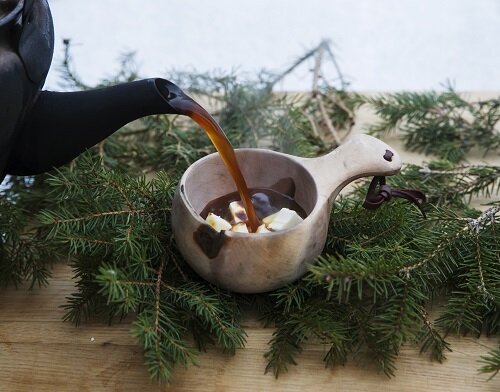7 Swedish Cheeses You Should Know
Sweden hasn’t received a lot of notoriety for its cheeses in the past, but that’s slowly changing. Many people don’t know that Sweden has among the most hard cheeses of any country, and its cheese industry continues to grow. In 2019, the Scandinavian country had four winners in the World Cheese Awards hosted in Italy. Here are some of the top cheeses (ost, in Swedish) you must try on any visit to Sweden — or ask your local cheesemonger about them.
Västerbotten
Västerbotten cheese photo credit Fabian Björnsterna
A Swedish cow’s milk cheese, this is named for the Västerbotten region in northern Sweden — a haven for nature lovers that’s known for its mountains, forests and salty sea breezes. Similarly, this cheese is quite salty, but also a little sweet: think of it as a cross between cheddar and Parmesan. It’s aged a minimum of 14 months on spruce shelves, which impart an aromatic quality to the cheese. To discover whether it’s aged enough, the master cheesemaker will extract a small slice with a drill. The final product is filled with tiny holes. Swedes love to pair Västerbotten with pickled herring, knäckebröd (Swedish crispbread usually made with rye flour) or fruit or bake it into a savory cheese pie or tart.
Kaffeost
Kaffeost photo credit Pernilla Ahlsén & Visit Sweden
A Swedish fika, the concept of taking a break with a cup of coffee and a sweet treat, is something we can all get behind. You can take it a step further and opt for the unusual tradition of kaffeost, which is where dried cheese — called juustoleipä — served inside a hot cup of coffee. Somehow, the spongy cheese softens but doesn’t melt. Juustoleipä word translates literally to “cheese bread,” which accurately describes how it soaks up whatever it’s paired with coffee, syrup, jam, you name it. To make this treat, simply add a cube of the cheese to the bottom of your mug and pour fresh-brewed coffee over the top. Enjoy immediately while hot, spooning out the chunks of cheese as you drink (lest it begin to separate as it cools).
Wrångebäck
Wrangeback photo credit Jesper Anhede
Wrångebäck has an illustrious past. It is the oldest registered cheese brand in Sweden, dating back to 1889. It was one of only two Swedish cheeses that were permitted to be produced without skimming the milk during WWII, as the cream was needed elsewhere to nourish the population, and Her Royal Highness the Queen even ordered it for a charity event at Haga castle in Stockholm. Made with methods similar to an alpine Gruyere, this raw cow’s milk cheese has a bit of a haggard appearance on the outside (to be honest, it looks like something you might find out in a pasture, thanks to its brown stone-like rind). Break into the center, though, and you’ll find a creamy, dense cheese that smells a bit like warm milk, with a hint of grassiness. Initially tangy, Wrångebäck mellows the longer it sits out, providing a luscious umami flavor that pairs well with an aged cabernet sauvignon.
Hushållsost
"Arla Hushallsost" by Like_the_Grand_Canyon is licensed under CC BY-NC 2.0
You may have never realized it, but in between the aisles of built-it-yourself furniture and minimalist design accents, IKEA has a mighty cheese section. The selections vary, but Hushållsost is one variety that’s usually available here. Aged 60 days and made from pasteurized cow’s milk, its buttery texture and pleasing tang make it the perfect well-rounded, crowd-pleasing cheese to add to any cheese board (try pairing with elderflower jam). It also melts fantastically well, making it the ideal cheese for things like quesadillas.
Ädelost
Ädelost Jorchr, CC BY-SA 3.0
Love blue cheese? You’ll go crazy for this semi-soft cow’s milk Swedish variety that is aged for 8-12 weeks and is one of Sweden’s “finer” cheeses. The signature blue-grey veins running throughout are a distinctive feature, and the cheese itself is known for its sharp, salty, tangy flavor, ideal for topping salads. Some like to enjoy this with Swedish gingerbread crackers popular at Christmastime called pepparkaka, which are very thin, crisp, and subtly spicy and complement the flavor of Ädelost nicely.
Herrgårdsost
Herrgardost photo credit Jakob Fiidholm & Visit Sweden
This semi-hard cow’s milk cheese is a go-to for sandwiches. Named for the Swedish port city of Vadenost, it has a pleasingly mild, sweet, slightly nutty flavor and small round holes, similar to Swiss cheese. Swedes compare the flavor to Gruyere or cheddar, but the big difference is that Herrgårdsost
is significantly softer. The basic variety found in supermarkets (often pre-sliced in a package) is aged for about six months, but Herrgardsost can be aged for up to 2 years to enhance its nutty flavor.
Kavli Mjukost
Editor’s note: A Norwegian brand, Kavli has a Swedish subsidiary and is very popular in Sweden.
OK, so it’s technically not a cheese, but Mjukost to Swedes is like Velveeta or Easy Cheese to Americans. This slightly strange, soft processed cheese (that’s found in the regular aisle of Swedish supermarkets) comes in a tube in many different savory flavors, from mushroom to chorizo to bacon and shrimp. Many Swedes grew up eating this as a snack as a child, on sandwiches or knäckebröd. Since it requires no refrigeration, it’s available in the U.S via Amazon.






